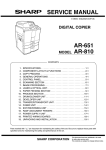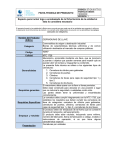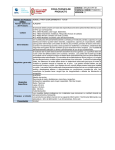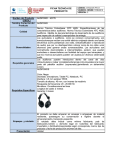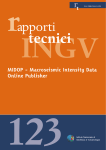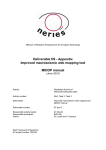Download BOXER User Guide Version 3.3 (November 2004) The “Boxer
Transcript
BOXER User Guide Version 3.3 (November 2004) The “Boxer” program was written by Paolo Gasperini in the April of 1999. It is a revised and simplified version of several computer codes which, starting from 1993, have been developed by the author, with the contribution of Filippo Bernardini and Graziano Ferrari, to compute focal parameters of earthquakes from macroseismic data and have also been actually used to compute synthetic earthquake parameters for the Catalogo dei Forti Terremoti in Italia dal 461 a.C. al 1990 [Boschi et al. 1995, 1997], the Catalogo Parametrico dei terremoti Italiani (CPTI) [Gruppo di lavoro CPTI, 1999] and to make the computation of the BSSA paper by Gasperini et al. [1999]. The program also took advantage of important improvements made by Gianfranco Vannucci (particularly regarding the code to generate MapInfo and GMT files) and by Gianluca Valensise (who also suggested the name). While the macroseismic epicenters, epicentral intensities and azimuths computed by Boxer fully coincide with those published in the above cited papers, the magnitudes may slightly differ (some tenth of magnitude unit at most) due to some differences in the relative weighting of various intensity classes. A description of the procedure to compute the azimuth and to draw the “boxes” representing the seismogenic structures can be found in Gasperini et al. [1999]. More details on the computation of epicenter and magnitude are reported by Gasperini and Ferrari [1995, 1997, 2000]. Changes with respect to previous versions This last release implements an improved method to compute magnitude using a weighting scheme also including the reliability of empirical regressions for each intensity class (see the description of option card MAGCOEF). As well a procedure to compute the necessary coefficients of magnitudeintensity relations is also provided (see description of option card COMPCOEF). This new method has been actually used for revaluing the magnitudes in the historical seismic catalog [Gruppo di Lavoro CPTI, 2004] in the framework of the recent INGV initiative for the computation of the new seismic hazard map of Italy [Gruppo di Lavoro Mappa di Pericolosità Sismica, 2004]. However, the default magnitude assessment method even for this version remains the same of previous ones. Therefore to use the new method this must be explicitly selected by the MAGCOEF option card. In this manual we also describe the previously undocumented option card MAPINFO directing the program to write import files for the MapInfo Graphic Information System (GIS) and the new GMT option card that activate the writing of input files for plot epicenters and boxes with the General Mapping Tool [Wessel and Smith, 1991]. Other minor changes concerned the formats of inputoutput files (FORMATI and FORMATE option cards). All significantly modified portion of the text below with respect to previous versions are highlighted with a yellow shading. Input and output The program reads optional parameters from the file INPPARM.DAT. The earthquake data are read instead from a separate file whose name and format can be specified by the user (see below). Both summary data for each earthquake (date, magnitude etc.) and the list of intensity observations are read from this file. All the files must reside in the same folder with the program executable. The program creates two kind of output: a shorter one on the file OUTSUMMARY.DAT, which contains a record for each earthquake including source parameters, and a longer one on the file OUTFULL.DAT also including details of computations. The procedure for the estimation of new regression coefficients also creates a file named OUTPARM.DAT which is a copy of file INPPARM.DAT with the new computed coefficients added. Option cards on file INPPARM.DAT Each option card includes a “verb” field (from columns 1 to 10) and in most cases even a “parameters” field (from columns 11 to 80). Some option cards are followed by one or more additional data cards with a “parameters” field from columns 1 to 80. The verb identifies the scope of the card and must be written from column 1 with either upper or lower case characters. A percent character (“%”) in column 1 indicates that the card is a comment and thus the program ignores its content. An alphabetical list of the available option cards follows: AZPAR - Assigns parameters of the azimuth computation algorithm COMPCOEF – Computes new coefficients for Magnitude-Intensity relations CRAMCOEF – Assigns coefficient of the distance weighting formula in the azimuth algorithm FILE - Defines the name of the macroseismic input data file GMT - Directs the program to produce files for GMT. FORMATE - Specifies the Fortran format of the event summary records of the input data file FORMATI - Specifies the Fortran format of the intensity observation records of the input data file LENGCOEF - Assigns coefficients of the fault length formula MAGCOEF - Assigns coefficients of the magnitude formula using the isoseismal area method MAPINFO - Directs the program to produce import files for MapInfo. M-I0COEF - Assigns coefficients of the magnitude-intensity formula OUTLOOK - Directs the program to write a fixed format summary file OUTPUT - Selects the type of output SELMAG - Defines the minimum magnitude for azimuth computations. USEMAG - Directs the program to use the magnitude reported on the event summary record WIDCOEF - Assigns coefficients of the fault width formula A detailed explanation of the format of each option card is given below: AZPAR Assigns the values of the minimum allowed number of data-points and the maximum allowed number of half degree decrements with respect to maximum intensity in the azimuth computation algorithm (see: Gasperini et al. [1999]). Parameter field: 1) Name: Nmin Function: minimum allowed number of data-points Columns: 11-15 Type: Integer Default: 3 2) Name: Ndecr Function: maximum allowed number of half degree decrements with respect to maximum intensity Columns: 16-20 Type: Integer Default: 4 Additional data cards None Example 1---------11--------21-------AZPAR 6 4 COMPCOEF When this option card is present, it is usually inserted as the first one of the cards deck. It directs the program to run the procedure computing the coefficient of magnitude-intensity regressions on the basis of instrumental magnitudes (taken from the event summary records) associated with macroseismic observations. All option cards (including comments) file located after this card are copied to OUTPARAM.DAT file with the exception of MAGCOEF and M-I0COEF. At the completion of computations new MAGCOEF and M-I0COEF cards with the computed regression coefficients are added to the end of the deck in OUTPARAM.DAT. Thus in order to apply the new parameters to further computations, the file OUTPARAM.DAT can be simply renamed as INPPARAM.DAT. Parameter field: 1) Name: Nmm Function: minimum allowed number of intensity observations for each intensity class used for calibrating regressions Columns: 11-15 Type: Integer Default: 5 Additional data cards None Example 1---------11--------21-------COMPCOEF 3 CRAMCOEF Assigns the values to the coefficients of the CRAM [Berardi et al., 1993] formula to compute the distance weights in the azimuth determination algorithm (see: Gasperini et al. [1999]) ΔI = a + b3 D where ΔI is the difference between epicentral and local intensity and D is the epicentral distance. Default values were empirically estimated for Italy by Gasperini et al. [1999]. Parameter field: 1) Name: Acram Function: a coefficient of the CRAM equation Columns: 11-20 Type: Real Default: -0.46 2) Name: Bcram Function: b coefficient of the CRAM equation Columns: 21-30 Type: Real Default: 0.93 Additional data cards None Example 1---------11--------21-------CRAMCOEF -0.3 1.1 FILE Assigns the name of the macroseismic data file containing the event summary records as well as the intensity observation records. Parameter field: 1) Name: Filename Function: name of the input data file Columns: 11-80 Type: Alphanumeric Default: INPUT.DAT Additional data cards: none Example 1---------11--------21-------FILE INPUT2.DAT FORMATE Allows to indicate the Fortran format (embedded in parenthesis) of the event summary records in the input data file. It must contain 9 (or 11) fields in the following order: Year (integer), Month (integer), Day (integer), Hour (integer), Minute (integer), Second (integer), Epicentral Area (alphanumeric), Magnitude (real), Number of intensity points (integer), Standard error of Magnitude (real), Epicentral intensity (real) (the last two fields are only required for the computation of magnitude-intensity coefficients). Tabulation (T fields) can be used to accomplish this order if different. Parameter field: none Additional data cards: Card 1 1) Name: Formate Function: Fortran format of event summary records Columns: 1-80 Type: Alphanumeric Default : (I5,5I2,15X,A20,1X,F5.1,1X,I5) Example: 1---------11--------21--------31-------41------FORMATE (8x,I5,5I3,1X,A20,64x,F3.2,T58,I4) FORMATI Allows to specify the Fortran format (embedded in parenthesis) of the intensity observation records in the input data file. It must contain 4 fields in the following order: Latitude (real), Longitude (real), Intensity (real), Locality name (alphanumeric). Tabulation (T fields) can be used to accomplish this order if different. Latitude and longitude must be given in decimal degrees (not degrees and primes). West longitudes can be specified with a negative sign. Uncertain intensity values (i.e. VII-VIII) may be given as fractional (i.e. 7.5) Parameter field: none Additional data cards: Card 1 Name: Formati Function: Fortran format of intensity data records Columns: 1-80 Type: Alphanumeric Default : (2F7.3,1X,F4.1,1X,A20) Example: 1---------11--------21--------31-------41------FORMATI (48X,2F8.4,F6.1,T30,A20) GMT Directs the program to create files for plotting epicenters, boxes etc. with GMT. The 5 binary digits of the unique parameter activate (1) or deactivate (0) the writing of Summary files of epicenters (file names: epi_input.gmt and epi_input.bat), Summary files of boxes and circles (file names: box_input.gmt, cir_input.gmt and box_input.bat)), Single files for epicenters (file names: ep_year_month_day_area.gmt and ep_year_month_day_area.bat), Single files for boxes or circles (file names: bx_year_month_day_area.gmt and bx_year_month_day_area.bat), Single files for intensity observation (file names: qt_year_month_day_area.gmt and qt_year_month_day_area.bat) respectively (input is the file name specified in the NAME option card, year, month, day and area are the year, month day and epicentral area read from the event summary record for the given earthquake). Parameter field: 1) Name: Iexcl Function: binary digits activating various GMT files Columns: 11-15 Type: Integer Default: 00000 Additional data cards None Example 1---------11--------21-------GMT 11000 LENGCOEF Assigns the values to the coefficients of the formula used to compute fault length from magnitude Log10 (L) = a + bM where M is the magnitude and L is the fault length in kilometers. Default values are empirical estimates for subsurface rupture length of “all types of fault” madeby Wells and Coppersmith [1993] as a function of moment magnitude. Parameter field: 1) Name: Alen Function: a coefficient of the fault length formula Columns: 11-20 Type: Real Default: -2.44 2) Name: Blen Function: b coefficient of the fault length formula Columns: 21-30 Type: Real Default: 0.59 Additional data cards None Example 1---------11--------21-------LENGCOEF -2.11 0.65 MAGCOEF Assigns the values of the coefficients, for different intensity class, of the Sibol et al [1987] formula to compute the macroseismic magnitude as a function of the isosesismal area and epicentral intensity M i = a + bLog 2 ( Ai ) + cI02 where Ai is the isoseismal area for the i-th intensity class, which is computed as Ai = πRi2 where Ri (in Km) is the average epicentral distance of localities belonging to the i-th intensity class. The magnitude of an earthquake is computed as the weighted average of the single estimates made using the intensity classes available for the given earthquake. If the number of intensity classes is 4 or larger the largest and lowest estimates are trimmed off the averaging. Two different methods can be selected to weight the estimates made by different intensity classes. For the older one (the only one available in previous versions of Boxer) the weight is simply assumed inversely proportional to the square of the logarithm of the number of available intensity observations. For the newer one the weight is inversely proportional to the number of intensity observations and to the square of regression standard deviation for the corresponding intensity class (computed during the coefficient computation run activated by COMPCOEF card). For the older method only the values of the 3 coefficients of Sibol et al. [1987] formula and the limits of intensity classes need to be reported on data cards described below. For the newer one three additional parameters are needed for each intensity class: the standard deviation of the regression, the weight normalization factor (corresponding to number of intensity observation for a unit weight) and the number of degrees of freedom of the regression (the number of data minus the number of free parameters). If the latter is different from zero for all of intensity classes the newer weighting method is selected. In absence of a MAGCOEF option card or if the third parameter is zero or blank for at least one intensity class, the older weighting method is used. Default values are empirical estimates made for Italy from the data of the Catalogo dei Forti Terremoti in Italia dal 461 a.C. al 1990 (2) [Boschi et al.. 1997] in terms of moment magnitude. Parameter field: 1) Name: Ncoef Function: number of intensity classes used to compute magnitude Columns: 11-15 Type: Integer Default: 10 Additional data cards Card 1 1) Name: Aiv(1) Function: Lower limit of the intensity class (the higher limit is specified in the next card) Columns: 1-15 Type: real Default: see below 2) Name: Coef(1,1) Function: a coefficient of the Sibol et al [1987] formula Type: real Columns: 16-30 Default: see below 3) Name: Coef(1,2) Function: b coefficient of the Sibol et al [1987] formula Type: real 4) 5) 6) 7) Columns: 31-45 Default: see below Name: Coef(1,3) Function: c coefficient of the Sibol et al [1987] formula Type: real Columns: 46-60 Default: see below Name: Stdr(1) Function: standard deviation of the regression (for new weighting method only) Type: real Columns: 61-68 Default: see below Name: Avme(1) Function: weight normalization factor (for new weighting method only) Type: real Columns: 69-76 Default: see below Name: Idfe(1) Function: degrees of freedom of regression (for new weighting method only) Type: integer Columns: 77-80 Default: see below Cards 2 to Ncoef Same as Card 1 for different intensity classes (with increasing intensity). Example: (The example values are the default ones) 1 MAGCOEF 2. 3. 4. 4.5 5. 6. 6.5 7. 7.5 8. 11 21 31 41 51 61 10 3.554 3.422 3.034 4.340 3.277 3.829 4.198 4.394 5.078 5.348 0.025 0.038 0.074 0.022 0.103 0.070 0.094 0.091 0.110 0.116 0.024 0.023 0.019 0.015 0.012 0.015 0.009 0.009 0.000 0.000 MAPINFO Direct the program to produce import files to create tables for MapInfo. The 5 binary digits of the parameter activate (1) or deactivate (0) the writing of import files for MapInfo tables of Summary files of epicenters (file names: epi_input.mid and epi_input.mif), Summary files of boxes and circles (file names: box_input.mid, box_input.mif, cir_input.mid and cir_input.mif)), Single files for epicenters (file names: ep_year_month_day_area.mid and ep_year_month_day_area.mid), Single files for boxes or circles (file names: bx_year_month_day_area.mid and bx_year_month_day_area.mid), Single files for intensity observation (file names: qt_year_month_day_area.mid and qt_year_month_day_area.mid) respectively (input is the file name specified in NAME option card, year, month, day and area are the year, month day and epicentral area read from the event summary record for the given earthquake). Parameter field: 1) Name: Iexcl Function: binary digits activating various MapInfo import files Columns: 11-15 Type: Integer Default: 00000 Additional data cards None Example 1---------11--------21-------MAPINFO 11000 M-I0COEF Assigns the values of the coefficients of the formula to compute macroseismic magnitude from epicentral intensity alone when the data are not sufficient to apply the areal method (see: Gasperini et al. [1999]) M = a + bI0 where M is the magnitude and I0 the epicentral intensity. Default values are calibrated for moment magnitude [Hanks and Kanamori, 1979] and have been empirically derived by combining the Ms-I0 relation estimated by Rebez and Stucchi [1999] for the Italian magnitude-intensity database Ms = 0.94(±0.13) + 0.56(±0.017)I0 with the Log M 0-Ms relation (in dyne cm) estimated for Italy and surrounding areas by Gasperini and Ferrari [2000] Log M 0 = 19.3(±0.3) + 0.96(±0.06)Ms = 20.20 + 0.538I0 and then with the definition of Mw by Hanks and Kanamori [1979] Mw = −10.7 + 2 /3Log M 0 = 2.768 + 0.3584I0 Parameter field: 1) Name: Aint Function: a coefficient of the M-I0 equation Columns: 11-20 Type: Real Default: 2.768 2) Name: Bint Function: b coefficient of the M-I0 equation Columns: 21-30 Type: Real Default: 0.3584 Additional data cards None Example 1---------11--------21-------M-I0COEF 1.5 0.5 OUTLOOK(undocumented) Direct the program to write a fixed-format summary file OUTPUT Select type of output (=1 normal output, >1 long output) Parameter field: 1) Name: Iout Function: type of output Columns: 11-15 Type: Integer Default: 1 Additional data cards None Example 1---------11--------21-------OUTPUT 2 SELMAG Direct the program to compute the azimuth only for earthquakes with magnitude larger than a given threshold. Parameter field: 1) Name: Aminmg Function: minimum magnitude threshold above which the azimuth is computed Columns: 11-15 Type: Real Default: none (no threshold) Additional data cards none Example 1---------11-------SELMAG 5.5 USEMAG Direct the program to use the magnitude value specified on the event summary line instead of the computed one. Parameter field: none Additional data cards none Example 1---------11-------USEMAG WIDCOEF Assigns the values of the coefficients of the formula to compute fault width from magnitude Log10 (W) = a + bM where M is the magnitude and W is the fault length in kilometers. Default values are empirical estimates for subsurface rupture width of “all types of fault” made by Wells and Coppersmith [1993] as a function of moment magnitude. Parameter field: 1) Name: Alen Function: a coefficient of the fault width formula Columns: 11-20 Type: Real Default: -1.01 2) Name: Blen Function: b coefficient of the fault width formula Columns: 21-30 Type: Real Default: 0.32 Additional data cards None Example 1---------11--------21-------WIDCOEF -1.3 0.29 References Berardi, R., C. Petrungaro, L. Zonetti, L. Magri and M. Mucciarelli (1993). Mappe di sismicità per l’area Italiana, ISMES/ENEL, 51 pp. Boschi, E., G. Ferrari, P. Gasperini, E. Guidoboni, G. Smriglio and G. Valensise (1995). Catalogo dei forti terremoti in Italia dal 461 a.C. al 1980, ING-SGA, Bologna, 973 pp. and a CD-ROM. Boschi, E., E. Guidoboni, G. Ferrari, G. Valensise and P. Gasperini (1997). Catalogo dei forti terremoti in Italia dal 461 a.C. al 1990, ING-SGA, Bologna, 644 pp. and a CD-ROM. Gasperini, P., and G. Ferrari (1995). Stima dei parametri sintetici, in: E. Boschi et al. (Eds.), Catalogo dei Forti Terremoti in Italia dal 461 a.C. al 1980, ING-SGA publ., 96-111. Gasperini, P., and G. Ferrari (1997). Stima dei parametri sintetici: nuove elaborazioni, in: E. Boschi et al. (Eds.), Catalogo dei Forti Terremoti in Italia dal 461 a.C. al 1990, ING- SGA publ., 56-64. Gasperini, P., and G. Ferrari (2000). Deriving numerical estimates from descriptive information:the computation of earthquake parameters. Annali di Geofisica, 43, 729-746. Gasperini P., Bernardini F., Valensise G. and Boschi E. (1999). Defining Seismogenic Sources from Historical Earthquake Felt Reports, Bull. Seism. Soc. Am., 89, 94-110. Gruppo di Lavoro CPTI (2004) (a cura di Gasperini P., Camassi R., Mirto C. e Stucchi M.), Catalogo Parametrico dei Terremoti Italiani, versione 2004 (CPTI04). INGV, Bologna, http://emidius.mi.ingv.it/CPTI/ Gruppo di Lavoro Mappa di Pericolosità Sismica (Stucchi M., Akinci A., Faccioli E., Gasperini P., Malagnini L., Meletti C., Montaldo V. e Valensise G.), (2004) Redazione della mappa di pericolosità sismica prevista dell’ordinanza PCM del 20 marzo 2003, n 3274, All. 1, INGV, Milano. disponibile a: http://zonesismiche.mi.ingv.it/documenti/rapporto_conclusivo.pdf Hanks T. C. e Kanamori H. (1979). A moment magnitude scale. J. Geophys. Res., 84, 2348-2350. Rebez A. and Stucchi M. (1999). Determinazione dei coefficienti della relazione tabellare Io/Ms, in Catalogo Parametrico dei Terremoti Italiani, ING,GNDT,SGA,SSN, 90 pp. Sibol, M. S., G. A. Bollinger and J. B. Birch (1987). Estimations of magnitudes in central and eastern North America using Intensity and Felt Area, Bull. Seism. Soc. Am., 77, 1635-1654. Wells, D. L. and K. J. Coppersmith (1994). New empirical relationships among magnitude, rupture length, rupture width, rupture area, and surface displacement, Bull. Seism. Soc. Am., 84, 974-1,002. Wessel P. and W.H.F Smith (1991). Free software helps map and display data, EOS Trans. Am. Geophys. Un., 72, 441












